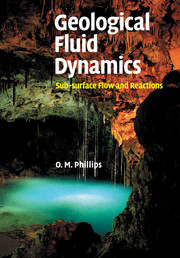2 - The basic principles
Published online by Cambridge University Press: 25 January 2011
Summary
Pores and fractures
The geological materials with which we are concerned usually lie at one extreme of the range of “porous media” encountered in nature and technology. The porosity, the volume fraction of connected voids that allow fluid movement, may be as large as 0.3 or 0.4 in a well-sorted sandbank or as small as 1% in natural calcite (Pryor, 1973). The skeletal remains of corals that abound in tropical reefs contain myriad interstices on scales of up to a centimeter or so and may have a similarly large porosity; Figure 2.1 shows a sample from Bermuda at approximately half-scale. This kind of structure containing fluid conduits as well as more numerous smaller pores is at the high-porosity extreme of those generally encountered. Compaction by overlying sediments, the infilling of interstices by finer grains, and the precipitation of cements from solution can reduce the porosity by an order of magnitude and reduce the permeability, as we shall see, by three orders of magnitude or more.
Many large pores are also apparent in dolomite from the Latemar Massif in northern Italy (Figure 2.2). Calcium ions from the original calcite mineral have been replaced by magnesium, generating dolomite. The specific volume of the dolomite produced in the reaction is less by 3–13% than that of the original calcite, so that as the reaction proceeded, the porosity increased.
- Type
- Chapter
- Information
- Geological Fluid DynamicsSub-surface Flow and Reactions, pp. 6 - 50Publisher: Cambridge University PressPrint publication year: 2009



